Reflections on the Sea after a Storm
Templestay at Haeinsa for Davidson College Students
Text by. Park Hyeon-suk Photo by. Ha Ji-kwon

Tak, tak, tak! When the bamboo clappers sounded three times, the dharma brothers and sisters entered meditation and sat motionless. The chirping of the mountain birds seemed to come and go in waves, and the wind rustled the leaves, but the meditators never budged. They sat cross-legged and motionless, like someone had pressed the “pause” button on a video. The smiles that had appeared on their faces while “paused” blossomed into loud laughter after they finished meditation. Like the young Sudhana who embarked on a journey in search of 53 virtuous teachers, these young people had come to Haeinsa Temple from the far-away United States. What was the mental landscape they encountered at Haeinsa Temple?
In early summer, the mountain temple was quiet at midday. Under the scorching sunlight, the wild birds and insects seemed to be dozing. Instead of heading toward Iljumun Gate from Haeinsa Temple's banner pole supports, I took the left path at the fork and walked for about 10 minutes. As I sat down on the wooden porch of Muajeongsa, the Templestay program’s accommodations, I could feel the season more closely at heart. Around 2 p.m., the shadow cast by Muajeongsa's roof grew darker and longer, and I heard voices and the sound of footsteps. Everyone’s faces were sweaty and red from the heat, but their eyes seemed full of wonder. The group had stayed at Golgulsa Temple in Gyeongju the day before, and their faces looked oddly curious as they pointed to the roof tiles, stone bases, and pillars that looked no different from those at any other temple. To them, Haeinsa Temple was another new temple, but quite amazing.
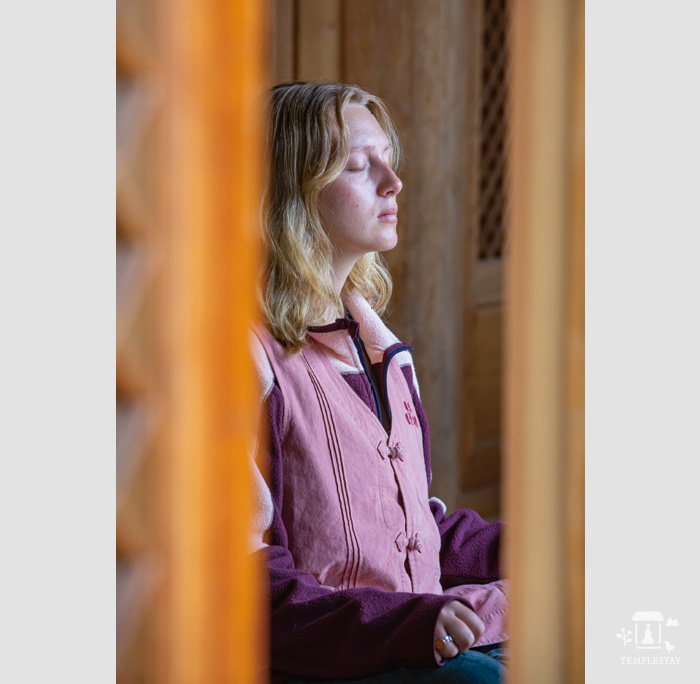
Why American College Students Came to Haeinsa Temple
Those who truly love music hear music everywhere. To them, even the common sounds of water flowing and wind blowing have a musical quality. Eleven such people, who are aware that the world is a place for learning for those truly eager to learn, recently visited Haeinsa Temple. They were professors and students from Davidson College, a prestigious arts college in North Carolina, and they came for a Templestay to learn about Korean Buddhism.
Daniel (Korean name Lee Yun-jae) is a college junior who immigrated to the United States as a child and is currently majoring in political science and French literature at Davidson College. He said, “I am a Christian, but I came to this Templestay because I wanted to learn about Buddhism. Meditation helped me a lot in my studies, so I naturally learned a little about Buddhism, which has a deep connection to meditation. It's always fun to learn something new.”
Professor Rachel, who teaches Tibetan Buddhism, said with a bright smile, “Haeinsa Temple radiates a very peaceful and refreshing feeling. I am happy to be in the home of Korean Buddhism and hope to learn a lot.”
Like a Tree Living in the “Now” while Embracing Growth
New experiences create a new self. The desire to experience new things comes from curiosity. The students' faces were filled with curiosity as they looked around Haeinsa Temple under the guidance of the Haeinsa Templestay team leader. They passed through the gates of Iljumun, Bonghwangmun, and Haetalmun, as well as the halls of Daebirojeon, Daejeokgwangjeon, and Janggyeong Panjeon. With a history of over 1,200 years, Haeinsa Temple is dotted with a harmonious assortment of dharma halls, pavilions, and gates. Like a forest that embraces all life forms, Haeinsa conveys deep Buddhist wisdom and hope.
Each space containing Buddhist teachings causes one to stop and think. The couplets written on the pillars of Iljumun Gate resonate in one's heart.
“Even after 1,000 eons have passed, it is not the past.
Even if the future continues another 10,000 years, it is always the present.”
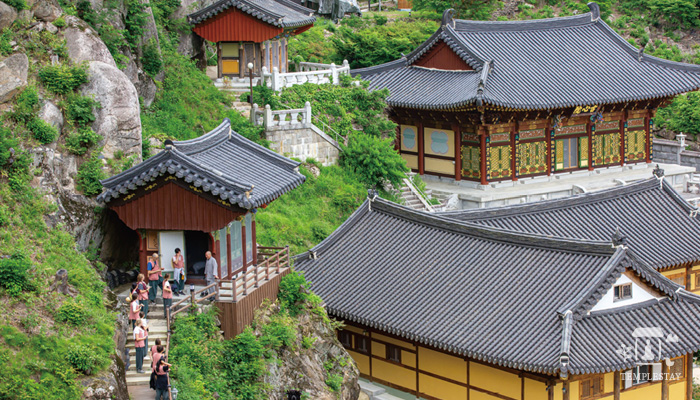
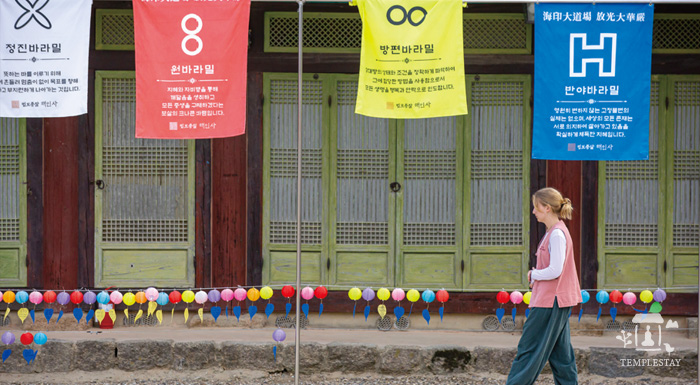
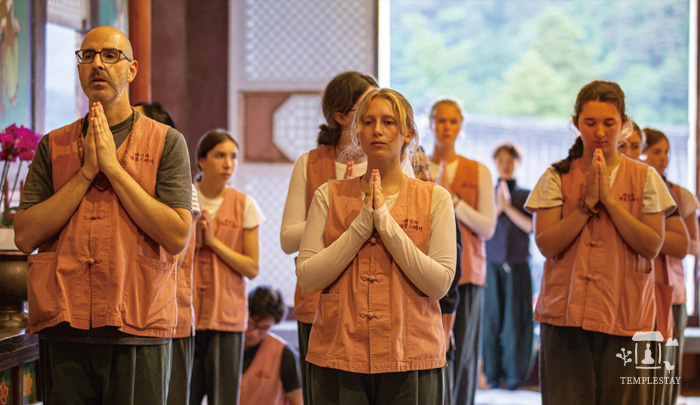
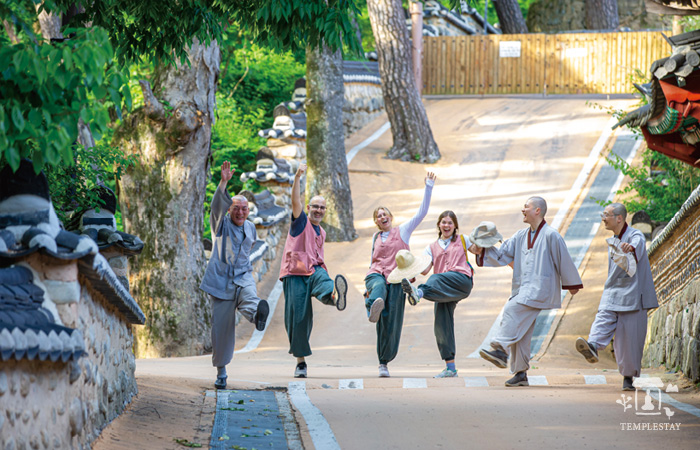
I resolved to live like a tree that lives in the present moment, embracing the growth rings that accumulate layer upon layer. The group of students and professors passed through Bonghwangmun (lit. Gate of the Phoenix) guarded by the Four Heavenly Kings, and passed through Haetalmun (lit. Gate of Liberation), moving toward the realm of enlightenment. They walked through Daebirojeon Hall where Vairocana Buddha is enshrined. He embodies the Buddha of the Dharma Body, the ultimate reality, and the integration of numerous buddhas and bodhisattvas.
They then passed Daejeokgwangjeon Hall, and finally reached Janggyeong Panjeon Hall which enshrines the printing woodblocks of the Tripitaka Koreana.
“I feel a special energy here,” said Ivan, who used to be a faculty member, but now serves as a Buddhist chaplain at Davidson College. To this remark, the team leader of Haeinsa’s Templestay smiled and said, “In 1995, UNESCO registered Haeinsa Temple’s Tripitaka Koreana printing woodblocks and the Janggyeong Panjeon as a World Cultural Heritage and a Memory of the World, respectively. The Tripitaka Koreana is a complete compilation of Buddhist scriptures, and has been preserved in near pristine condition for over 800 years. During the Korean War, General Kim Yeong-hwan received an order to bomb Haeinsa Temple to prevent it being used by the enemy, but he refused to obey the order and saved the Tripitaka Koreana and the repository. I think you felt a special energy here because of its amazing history.”
There are a total of 81,357 printing woodblocks in the Tripitaka Koreana, which contains Buddhist sutras, vinaya, and commentaries. The Chinese characters are perfectly uniform, and even though they were carved by 1,600 different people, they appear to have been written by a single person. The thickness of one plate is 3.6cm, and if stacked in a column, it is said to be taller than Mt. Baekdusan. We then took time to reflect on the hearts of those who created the Tripitaka Koreana to overcome the national crisis caused by the Mongol invasion in the 13th century, as well as the hearts of those who have protected the woodblocks for the last 800 years.
A Mental Landscape Encountered for the First Time
“What is your first impression of Korean temples?”
In response to this question from Ven. Hyeonsa, the guiding monk of the Haeinsa Templestay who presided over the tea ceremony, Neve smiled brightly and answered, “Fancy!” Diverse comments came from others, including “peaceful” and “novel.” Ven.
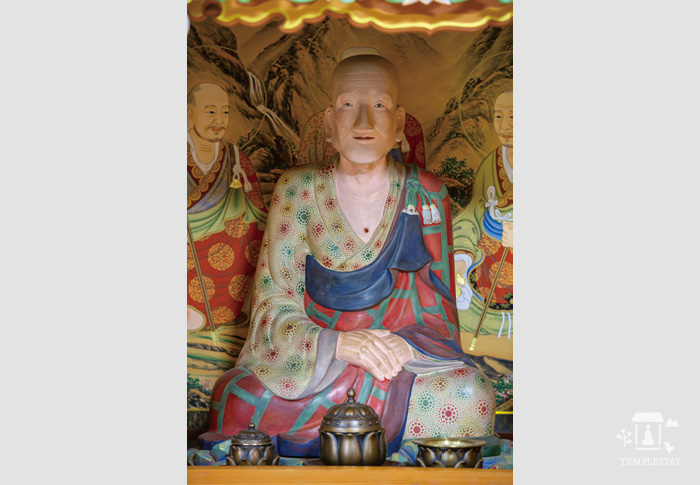

Hyeonsa then asked, “What do you think Buddhism is?” A participant named Ivan said, “To me, Buddhism has the answer to all of life’s questions.” Ven.
Hyeonsa responded, “Oh, that’s impressive! Buddhism teaches that you have to look within yourself to begin to change the world. It teaches that the way to block out the entire universe at once is simply to close your eyes. We Buddhist practitioners live a very simple and fulfilling life. The word 'Haein'—which appears in the Flower Garland Sutra—is connected to the concept of 'Right View,' which means to see things correctly.
This should be the attitude of a Buddhist practitioner.
We often don't see an object 'as it is' due to our wants and desires. We need to check whether this is an obstacle to having Right View. This is the attitude that students like you and I should not forget.”
After the tea ceremony, Ven. Hyeonsa introduced the Templestay group to the young student monks of Haeinsa Temple, whom they ran into on the way to the refectory. He explained to the young monks that the visitors were “our dharma brothers and sisters who had come from far away in the United States,” and he invited the student monks to come with them to the refectory. There was no awkwardness between Ven. Hyeonsa, the student monks, and the students from Davidson College. They all had something in common: “walking on the path of learning.”
After the evening meal offering, the participants went to Beomjongnu Pavilion to listen to the sound of the Dharma drum, followed in order by the temple bell, cloud-shaped gong, and wooden fish. The quiet temple compound was filled with deep, resonant sounds that reverberated throughout the entire Mt.
Gayasan area, sounds intended to save all sentient beings. A bluish twilight had already set in, and my gaze fell on a female participant named Sydney, who appeared to be doing walking meditation alone while walking on Haeindo. Haeindo is a design laid out on the ground in the courtyard in front of Daejeokgwangjeon Hall. It was created by Master Uisang in the 7th century to illustrate symbolically Hwaeom/Avatamsaka thought. I asked how she was feeling, but she just smiled, as if wanting to keep it to herself. After the evening Buddhist ceremony, the group exited Daejeokgwangjeon Hall. It was dark enough that only the silhouette of the mountain temple remained, like an ink painting devoid of color.
Dreaming of Haein Samadhi
The next day, the participants woke up at 4 a.m., took part in the morning Buddhist ceremony, and had a meditation session with Ven. Hyeonsa in Seollimwon Hall, the Templestay meditation hall for Haeinsa Temple. Ven. Hyeonsa said, “The Buddha said that all living beings have buddha nature in their hearts. Let’s take the time to encounter our ‘true self’ where our buddha nature dwells. Don't try to avoid the diverse thoughts that arise. Just notice them and observe them quietly.”
Opening the doors of Seollimwon Hall wide, they entered and sat cross-legged, breathed in the fresh early morning air, and gazed at the ridgeline of Mt. Gayasan in the distance. Then Ven. Hyeonsa's bamboo clapper sounded three times to begin the meditation session. Everyone sat motionless. The sounds of mountain birds and the breeze occasionally interrupted the silence, but the participants seemed not to notice and remained still. I found this scene touching, and it reminded me of the term “Haein Samadhi” mentioned in the Flower Garland Sutra. Just as all things are reflected as they are on a calm, flat sea, Haein Samadhi is a state where all things are revealed as they are when our afflictions and defilements cease. Isn't Haein Samadhi possible for those who walk the path of learning with an open mind?
After our meditation, we climbed the verdant Mt. Gayasan and visited Huirangdae Hermitage. Ven. Beobyu, who practices here, served us tea. It was a special feeling to look at the statue of Master Huirang enshrined there and listen to his story while drinking tea. Ven. Beobyu said, “Do you see the hole in the statue's chest? It is said to symbolize the light of wisdom that comes from a true practitioner. It is also said to be the hole through which Master Huirang offered his own blood to mosquitoes.
It is said he invited mosquitoes to enter his chest cavity and feed on his blood every evening. That's why there were no mosquitoes at Haeinsa Temple back then.” As the group left Huirangdae and headed further up Mt. Gayasan, Ven. Beobyu said, “As summer deepens, the flowers will come into full bloom here. Come again then!” That kind remark left a lasting impression.
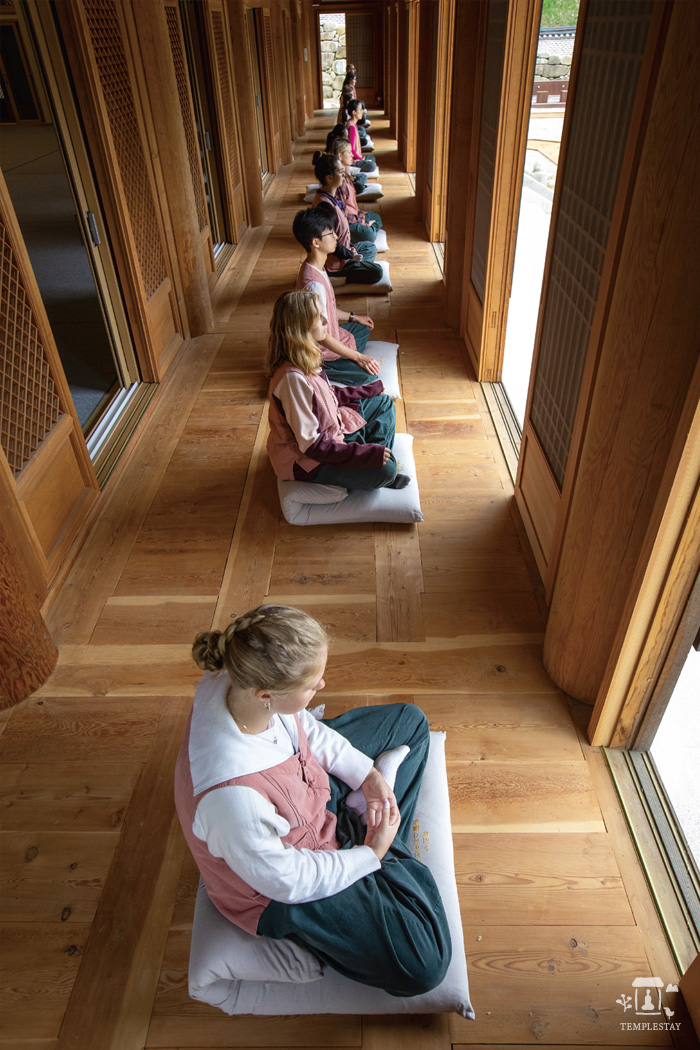
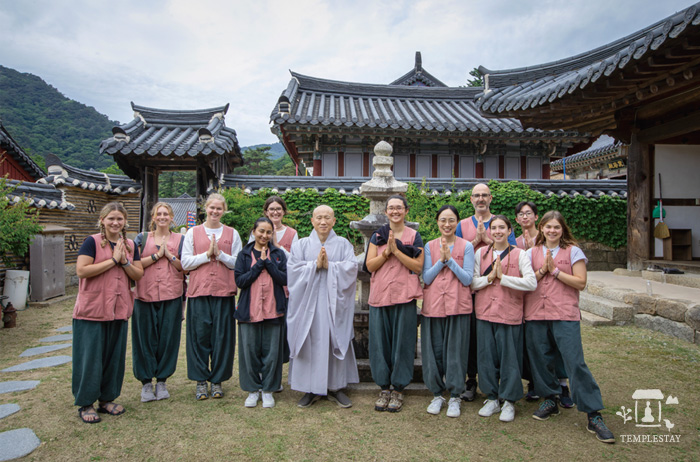
About the Wisdom of the Ancient Future
The participants came down from Mt. Gayasan and tried their hand at copying Buddhist scriptures, after which they took a walk around the temple compound.
Then they met with Ven. Hyeil, the abbot of Haeinsa Temple, and had tea with him. When asked to share his own life wisdom with the group, he said, “Youth is a time when you have many dreams and many things you want to do. People often say that you should live your life doing whatever you want, but if you just do that, you may be just wasting your time. I hope you live your lives intelligently and with an attitude that considers the public good and thinks about the world.” He then talked about the Tripitaka Koreana, which has served as a spiritual force to overcome various national crises ever since the Goryeo Dynasty. He suggested it as a solution to problems that threaten the Earth today, such as the climate crisis, war, and the spread of artificial intelligence. He said, “The Tripitaka Koreana is a product of the great spirit of humanity that is greater than Korea. I believe in the power of that spirit. For a peaceful future for the Earth and for humanity, Haeinsa Temple will begin a new project to engrave the Tripitaka Koreana again within five years.”
The tea cooled, but the conversation did not. The students on the path of learning and the monks on the path of practice continued to converse, each with their own unique academic perspective, and through the conversation, the students seemed to grow in their commitment to themselves and the world.
To me, the sight of participants focused not only during ceremonies and group meditation, but also during their own individual meditation alone was as inspiring as Mt. Gayasan in the summer. Someone who calms the storm in his/her mind and observes himself/herself quietly is an inspiration. The words of the Tibetan Buddhist sage Milarepa came to mind.
“No matter what happens, look at it with an open mind that is detached from everything; that in itself creates great power.”
Park Hyeon-suk is a freelance writer and interviewer. She loves Korea's traditional culture and nature, dreams of “ancient futures” (a concept proposed by Helena Norberg-Hodge) and pursuing sustainable values. She has met with individuals who embody intangible cultural assets and who pass down traditions from generation to generation. She has promoted Korean culture through the quarterly magazines Hanok and Koreana.
Haeinsa Temple
+82-55-934-3000
http://www.haeinsa.or.kr





